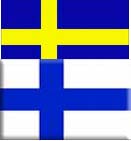Sweden and Finland mark bicentenary of separation
 Stockholm - The ceremony to mark the bicentenary of the separation in 1809 of Finland and Sweden got under way in Stockholm Thursday in the presence of Swedish King Carl Gustaf and Finnish President Tarja Halonen.
Stockholm - The ceremony to mark the bicentenary of the separation in 1809 of Finland and Sweden got under way in Stockholm Thursday in the presence of Swedish King Carl Gustaf and Finnish President Tarja Halonen.
The year 1809 has different connotations in the two countries - if remembered at all as a historic date, as several speakers and historians have observed.
The two heads of state attended the ceremony in the Swedish parliament where dignitaries included the speakers of both the Finnish and the Swedish legislatures, Swedish Prime Minister Fredrik Reinfeldt, Finnish Prime Matti Vanhanen and Swedish Queen Silvia and Crown Princess Victoria and Madeleine.
Representatives of parliament, business and culture from the two countries were also present.
For Sweden, the September 1809 peace treaty with Russia meant the loss of a third of its territory and a fourth of the population - a traumatic event.
"Sweden and Finland before 1809 were not a pair of siblings, but rather Siamese twins," said Horace Engdahl, permanent secretary of the Swedish Academy, the body that selects the Nobel Prize for literature.
Prior to 1809, Finland and Sweden were in many aspects regarded as one entity for over 600 years, sharing joint administration, legislation and economy, even though the majority of the inhabitants in the eastern part - what is Finland today - spoke Finnish.
Finland still has two official languages - Finnish and Swedish - and some 5-6 per cent of the population of 5.3 million have Swedish as their mother tongue.
In his speech in parliament, Engdahl remarked that the events of 1809 at least in Sweden were not widely remembered and a kind of "collective amnesia" exists.
The events also contributed to a new Swedish constitution and division of powers between the monarch, parliament and independent institutions as well as freedom of the press, he said.
Another effect was a re-orientation of Sweden towards Scandinavia and traditional rival Denmark, paving the way for future greater Nordic cooperation.
Swedish premier Reinfeldt said the year also offered a chance to "highlight 200 years of good cooperation, especially in recent years."
For Finland, the events of 1809 are more easily remembered since Finland became an autonomous Grand Duchy within the Russian Empire, and was to declare independence in 1917, he said.
Since 1995, both Nordic neighbours are members of the European Union, and cooperate closely on numerous issues - but compete strongly in sports.
Swedish Foreign Minister Carl Bildt, who chairs a Swedish committee responsible for organizing the commemorative events, said a joint meeting of the two cabinets in mid-May in Finland was "both symbolic and could offer concrete results."
Issues likely to be discussed included improving the environment of the Baltic Sea and further enhancing business cooperation and educational exchange, as well as efforts to tackle climate change.
A historical commemoration of an event like the year 1809 "also offered an opportunity to increase interest in history," Bildt said.
"But it also offers an opportunity to build on even closer cooperation in the future," he said.
The coming year includes numerous joint exhibitions and events in both countries with many artists, musicians and conductors employed by institutions in both countries.
"Many events are linked to music and dance where language divides do not matter as much," said Henrik Wilen, head of cultural affairs at the Finnish embassy.
Swedish commemorative stamps and a special 1-krona (12 US cents) coin - to be used in regular circulation - were also presented. (dpa)